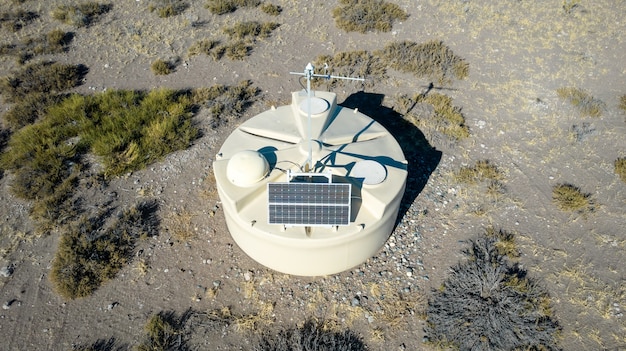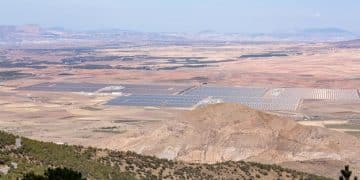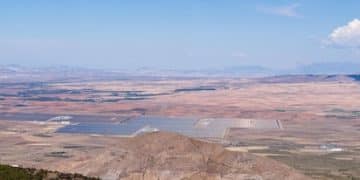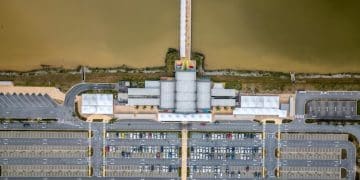US Investors in Mexico’s Renewable Energy: Key Considerations

Navigating Mexico’s renewable energy sector demands US investors consider regulatory frameworks, political stability, infrastructure, and financial incentives to ensure successful and sustainable ventures.
As the global push for sustainable energy intensifies, Mexico emerges as a compelling frontier for clean power initiatives. Understanding What are the Key Considerations for US Investors in Mexico’s Renewable Energy Sector? is crucial for those looking to leverage its abundant natural resources and strategic location.
The Lure of Mexico’s Renewable Landscape
Mexico’s geographical advantage, boasting extensive coastlines, vast deserts, and strong wind corridors, positions it as a natural powerhouse for renewable energy generation. This inherent potential, combined with a growing demand for electricity and a commitment to climate goals, presents a unique proposition for international investors, particularly from the United States.
However, the journey into this dynamic market requires a nuanced understanding of its intricacies. Past energy reforms, though aimed at liberalization, have seen periods of policy shifts, creating an environment that balances opportunity with a certain degree of perceived risk. For US investors, the appeal extends beyond simple geography; it encompasses the evolving regulatory framework, the commitment to renewable targets, and the potential for long-term growth.
Abundant Natural Resources
Mexico’s diverse topography provides a rich array of renewable resources. Solar irradiation levels in northern states rival some of the best globally, while wind speeds in regions like Oaxaca and the Yucatán Peninsula are consistently high. Geothermal potential, particularly along the Pacific Ring of Fire, also adds to the country’s clean energy portfolio.
- ☀️ Solar: High irradiation in Chihuahua, Sonora, and Baja California.
- 🌬️ Wind: Strong, consistent winds in Oaxaca, Jalisco, and the Yucatán.
- 🌋 Geothermal: Significant potential in Baja California and states along the volcanic belt.
- 💧 Hydro: Existing infrastructure with potential for expansion and modernization.
These natural endowments form the bedrock of Mexico’s renewable energy aspirations. Projects leveraging these resources can benefit from inherent cost advantages and predictable generation profiles, making them attractive for long-term investments. Understanding the specific resource availability per region is vital for project viability and efficiency.
Growing Energy Demand and Climate Goals
Mexico’s growing economy and expanding population necessitate a continuous increase in energy supply. This demand, coupled with the government’s commitment to reduce greenhouse gas emissions and meet renewable energy targets, creates a powerful incentive for domestic and international investment. The country has set ambitious goals for clean energy participation in its national grid, providing a clear market signal.
These targets translate into concrete opportunities for renewable energy developers and financiers. The Clean Energy Certificates (CELs) market, though subject to adjustments, represents a mechanism to incentivize clean energy generation. Aligning investment strategies with Mexico’s energy transition plans can unlock significant value and contribute to the nation’s sustainable development.
Ultimately, Mexico’s renewable energy sector is characterized by its vast natural potential and a clear national imperative for clean energy adoption. For US investors, this combination suggests a market ripe for exploration, provided the underlying considerations are thoroughly evaluated.
Navigating the Regulatory and Political Landscape
The regulatory and political environment in Mexico is arguably the most critical consideration for US investors. Energy policy has undergone significant transformations in recent years, oscillating between market liberalization and increased state control. Understanding these shifts and their implications is paramount for de-risking investments and ensuring project longevity.
Understanding Energy Reforms and Policy Shifts
Recent administrations have sought to reassert state control over the energy sector, particularly through strengthening state-owned enterprises like CFE (Federal Electricity Commission) and Pemex (Mexican Petroleum). This has sometimes led to policy changes perceived by some as less favorable to private renewable energy projects, including modifications to auction mechanisms, transmission priority rules, and grid access regulations.
Investors must closely monitor legislative developments, administrative decrees, and court rulings that could impact their projects. Engagement with legal and policy experts on the ground is indispensable to stay abreast of the evolving landscape and to interpret potential ambiguities in regulations. A proactive approach to understanding these nuances can help in mitigating risks and identifying adaptable investment pathways.
The implications of these shifts can be far-reaching, affecting project financing, operational costs, and the overall bankability of renewable assets. Strategic partnerships with local entities and a deep understanding of Mexican energy law often prove invaluable in navigating this complex terrain successfully.
Political Stability and Investment Climate
While Mexico generally enjoys a stable democratic system, individual policy decisions can create uncertainty. Recent policy efforts, though framed as strengthening national energy sovereignty, have raised concerns among some international investors regarding regulatory predictability and contract sanctity. Events such as the suspension or amendment of regulations related to renewable energy auctions and grid dispatch have underscored the dynamic nature of the investment climate.
For US investors, assessing the political appetite for private sector participation in renewable energy, particularly large utility-scale projects, is crucial. This involves not only observing public statements but also analyzing the practical implementation of policies. A climate that fosters transparency, fair competition, and adherence to established legal frameworks is vital for attracting and retaining foreign direct investment.
Maintaining open lines of communication with Mexican government agencies and industry stakeholders can provide valuable insights into the prevailing political winds. Establishing a strong local presence and cultivating relationships built on mutual trust can also help navigate periods of policy transitions. Ultimately, a thorough political risk assessment forms an integral part of any investment decision in Mexico’s energy sector.

Economic Feasibility and Financial Incentives
Beyond the political and regulatory environment, the economic feasibility of renewable energy projects in Mexico hinges on a combination of financial incentives, market pricing, and investor access to capital. Understanding these elements is crucial for building a robust investment case and ensuring project returns.
Access to Financing and Investment Structures
Securing adequate financing is a cornerstone of any large infrastructure project. In Mexico, renewable energy projects can tap into various financing avenues, including private equity, debt financing from local and international banks, and development finance institutions. The availability and terms of financing are often influenced by the perceived risk profile of the project and the broader economic climate.
US investors may find opportunities to structure investments through joint ventures with Mexican developers, leveraging local expertise and relationships. Project finance structures, common in the energy sector, typically involve non-recourse or limited-recourse debt, where repayment is primarily from the project’s cash flows. Understanding the intricacies of Mexican lending practices, guarantee mechanisms, and legal frameworks for collateral is essential.
Furthermore, the participation of multilateral development banks and export credit agencies can de-risk projects, making them more attractive to commercial lenders. Investors should explore all available avenues to optimize the capital stack and ensure competitive financing terms throughout the project lifecycle.
Capital markets in Mexico are also evolving, presenting opportunities for bond issuance and other financial instruments to fund renewable energy initiatives. The ability to access diverse pools of capital can significantly enhance project viability and scalability.
Market Pricing, PPAs, and Clean Energy Certificates (CELs)
The revenue stream for renewable energy projects in Mexico primarily comes from power purchase agreements (PPAs) and the sale of Clean Energy Certificates (CELs). PPAs typically involve long-term contracts for the sale of electricity to large consumers or the national grid, providing stable cash flows.
- 📝 Power Purchase Agreements (PPAs): Long-term contracts for electricity sales, crucial for project bankability.
- 📈 Wholesale Electricity Market (MEM): Dynamic spot market for energy sales, influenced by supply and demand.
- 🌿 Clean Energy Certificates (CELs): Market-based instrument incentivizing clean energy generation.
- 💲 Market Volatility: Understanding price fluctuations in the wholesale market.
The Mexican wholesale electricity market (MEM) operates on principles designed to promote competition, though its structure has seen adjustments. Prices in the MEM are influenced by a multitude of factors, including fuel costs, generation capacity, and transmission availability. Understanding the dynamics of this market is vital for projecting future revenues and assessing the long-term profitability of projects.
The CELs market, introduced as part of the energy reform, mandates that large electricity consumers and suppliers must procure a certain percentage of their electricity from clean energy sources, evidenced by CELs. While the rules governing CELs have been subject to some debate and modification, they remain a significant financial incentive for renewable energy producers. Investors must carefully analyze the prevailing CELs prices and the regulatory framework governing their issuance and trading to accurately forecast additional revenue streams.
Furthermore, the competitive landscape for PPAs requires robust financial modeling and a clear understanding of pricing strategies. Negotiating favorable PPA terms with creditworthy off-takers is critical for project success.
In summary, the financial allure of Mexico’s renewable sector is tangible, yet it is intricately linked to a thorough understanding of financing options, market mechanisms, and the crucial role of clean energy incentives.
Infrastructure and Grid Integration Challenges
Even with ample natural resources and favorable financial mechanisms, the success of renewable energy projects is heavily reliant on the existing infrastructure and the ability to seamlessly integrate new generation capacity into the national grid. Mexico presents unique challenges and opportunities in this regard.
Transmission and Distribution System Limitations
Mexico’s national transmission grid, managed by CENACE (National Energy Control Center), faces limitations in capacity and geographical reach, particularly in areas rich in renewable resources but distant from major consumption centers. New renewable projects often require significant grid upgrades or new transmission lines, which can be costly and subject to permitting and right-of-way challenges.
The process for securing interconnection agreements and grid access can be complex and time-consuming. Investors must conduct thorough due diligence on grid availability and the potential for curtailment (when renewable energy generation is reduced due to grid constraints). Understanding CENACE’s long-term grid expansion plans and participating in relevant studies or discussions can help mitigate these risks.
Investment in smart grid technologies, energy storage solutions, and localized microgrids may become increasingly important to overcome existing transmission bottlenecks and enhance grid stability. These solutions can also provide additional revenue streams and improve the overall efficiency of clean energy deployment.
Regional disparities in grid reliability and capacity can also impact project siting decisions. Projects located closer to existing substations or high-density load centers might face fewer interconnection hurdles and potentially lower infrastructure development costs.
Permitting Processes and Land Acquisition
The journey from project conception to operation in Mexico involves navigating a multi-layered permitting process that includes federal, state, and municipal authorities. Permits for environmental impact, land use, construction, and power generation can be extensive and require diligent management. Delays in obtaining these permits can significantly impact project timelines and costs.
Key agencies involved typically include SEMARNAT (Ministry of Environment and Natural Resources), CRE (Energy Regulatory Commission), and CENACE. Each has specific requirements and timelines that investors must anticipate. Establishing a strong local project development team with expertise in Mexican permitting regulations is invaluable.
Land acquisition is another critical consideration, particularly for large-scale solar and wind farms. This often involves negotiating with ejido (communal land) owners, private landowners, or indigenous communities. Understanding Mexican land tenure laws, engaging in transparent and respectful negotiations, and building community support are essential for successful land acquisition and avoiding social conflicts that could delay or derail projects.
Early engagement with local communities and stakeholders can help identify potential issues, build trust, and ensure that projects proceed smoothly while respecting local customs and land rights. Incorporating social impact assessments and community benefit agreements can further streamline this process.
In summary, while Mexico’s infrastructure requires significant investment, understanding and proactively addressing grid limitations and complex permitting processes are vital steps toward successful project implementation.
Risk Mitigation and Local Collaboration
Investing in any emerging market carries inherent risks, and Mexico is no exception. For US investors in the renewable energy sector, effectively mitigating these risks and fostering strong local collaborations are essential for long-term success and sustainable operations.
Managing Legal, Environmental, and Social Risks
Legal risks extend beyond regulatory changes to include contract enforcement, intellectual property protection, and dispute resolution mechanisms. While Mexico has a well-established legal system, understanding its intricacies and having robust contractual agreements are paramount. Incorporating international arbitration clauses in contracts can offer an added layer of protection and impartiality.
Environmental risks, such as water availability for cooling or panel cleaning, biodiversity impacts, and waste management, must be thoroughly assessed and addressed through comprehensive environmental impact assessments (EIAs). Adhering to Mexican environmental regulations and international best practices not only ensures compliance but also enhances project reputation and sustainability.
Social risks often revolve around community engagement, labor practices, and the impact of projects on local livelihoods. Failure to address these concerns can lead to protests, legal challenges, and significant project delays. Implementing robust social management plans, including benefit-sharing agreements, local employment initiatives, and culturally sensitive communication strategies, is crucial for fostering positive community relations.
- ⚖️ Legal: Contract enforcement, dispute resolution, intellectual property.
- 🌍 Environmental: Water usage, biodiversity impact, waste management.
- 🤝 Social: Community engagement, labor practices, local impact assessments.
- 🤝 Land: Ejido negotiations, right-of-way, community consent.
Furthermore, corruption perception, while decreasing, is an ongoing concern in Mexico. US investors must implement stringent anti-corruption policies and conduct thorough due diligence on all local partners and service providers to ensure compliance with the Foreign Corrupt Practices Act (FCPA) and other relevant regulations.
Benefits of Local Partnerships and Expertise
Partnering with experienced local firms, developers, or legal counsel offers numerous advantages. Local partners possess invaluable insights into the Mexican market, regulatory nuances, cultural specificities, and established networks. They can help navigate bureaucratic hurdles, understand unwritten rules, and facilitate smoother interactions with government agencies and local communities.
A strong local team can also provide real-time intelligence on policy shifts, community sentiment, and emerging market trends. This localized expertise helps in adapting business strategies dynamically and ensures that projects are not only compliant but also culturally and socially accepted.
Joint ventures can also share risks, pool resources, and combine international best practices with local knowledge. For US investors, a reliable Mexican partner can be the difference between a challenging venture and a successful, profitable operation. Recruiting local talent and investing in local capacity building can also contribute to the long-term sustainability and positive impact of the investment.
In essence, proactive risk management, coupled with strategic local collaboration, forms an unshakeable foundation for any US investor venturing into Mexico’s dynamic renewable energy sector.
Growth Opportunities and Future Outlook
Despite the challenges, Mexico’s renewable energy sector remains poised for significant growth, driven by fundamental long-term trends and the imperative for sustainable development. For US investors, identifying these growth opportunities and understanding the future trajectory of the market is key to strategic positioning.
Emerging Technologies and Niche Markets
While utility-scale solar and wind projects have traditionally dominated, emerging technologies present new avenues for investment. Distributed generation, including rooftop solar for residential and commercial consumers, is a rapidly expanding market segment driven by rising electricity costs and the desire for energy independence. This decentralized approach offers resilience and can bypass some large-scale grid integration challenges.
Energy storage solutions, particularly battery storage, are becoming increasingly crucial for grid stability and integrating intermittent renewable sources. Investments in battery manufacturing, assembly, and deployment could see significant uptake. Hydrogen production from renewable sources (green hydrogen) is also an nascent but promising area, with Mexico’s potential for abundant low-cost renewables positioning it as a future hub.
Furthermore, niche markets such as off-grid solutions for remote communities, agricultural applications of solar power, and the modernization of existing hydroelectric facilities offer diversified investment opportunities. These smaller-scale, often community-oriented projects, can provide significant social benefits alongside financial returns.
Understanding the technological landscape and identifying which innovations are best suited for the Mexican context can give investors a competitive edge. Early adoption of these technologies, where feasible, can position investors at the forefront of the market’s evolution.
Long-Term Market Potential and Strategic Alliances
Mexico’s long-term energy demand trajectory, coupled with its international commitments to climate action, provides a strong structural basis for continued growth in renewables. Despite short-term policy fluctuations, the fundamental need for clean, affordable, and reliable energy will persist.
Strategic alliances with large industrial consumers, local utilities, and even state-owned enterprises could unlock significant opportunities. These alliances can provide stable off-take agreements, facilitate grid access, and mitigate political risks. Exploring opportunities to supply green energy to multinational corporations operating in Mexico, many of which have their own sustainability targets, represents a burgeoning market.
Furthermore, Mexico’s strategic location as a bridge between North and Latin America, along with its participation in trade agreements like the USMCA (United States-Mexico-Canada Agreement), can facilitate cross-border energy trade and investment. The potential for exporting clean energy to the US, particularly from border states, could become a significant driver of future growth.
While challenges exist, the underlying market fundamentals and the potential for technological innovation suggest a robust future for Mexico’s renewable energy sector. Strategic foresight and adaptive investment strategies will be key for US investors to capitalize on these enduring opportunities.

Legal Frameworks and Investment Protection
The legal frameworks governing foreign investment in Mexico, particularly within the energy sector, are critical for US investors. Understanding these protections and potential recourse mechanisms provides a necessary layer of confidence and risk mitigation for long-term project planning and execution.
Bilateral Investment Treaties (BITs) and USMCA
The United States and Mexico are parties to several international agreements that offer protections for cross-border investments. Foremost among these is the United States-Mexico-Canada Agreement (USMCA), which replaced NAFTA. Chapter 14 of USMCA specifically addresses Investment, providing protections against certain actions by host governments, such as expropriation without compensation, and ensuring non-discriminatory treatment for foreign investors.
These provisions are designed to create a more stable and predictable investment environment. For US investors, the ability to invoke dispute resolution mechanisms under USMCA in cases of alleged breaches of investment obligations can be a powerful tool. Understanding the scope and limitations of these protections is vital.
While USMCA offers a robust framework, interpretation and application can be complex. Investors should consult with legal experts specializing in international trade and investment law to fully understand their rights and potential avenues of recourse under the agreement. The existence of such agreements does not eliminate risk but provides a formal framework for addressing investment grievances.
Beyond USMCA, Mexico is also party to numerous other bilateral investment treaties (BITs) with various countries, which may offer additional or complementary protections. While the direct relevance to US investors might primarily be through USMCA, awareness of the broader treaty network can be beneficial for specific structuring decisions.
Dispute Resolution Mechanisms
In the event of a dispute, US investors in Mexico’s renewable energy sector have several resolution mechanisms available. These typically include:
Local Courts: While available, navigating the Mexican judicial system can be time-consuming and complex, particularly for foreign entities. Understanding the local civil and commercial codes is essential if resorting to this option.
International Arbitration: This is often the preferred method for resolving disputes between international investors and host states or local partners. Arbitration clauses within investment contracts, referencing international bodies such as ICSID (International Centre for Settlement of Investment Disputes) or ICC (International Chamber of Commerce), provide a neutral forum for dispute resolution.
State-to-State Dispute Settlement under USMCA: In certain instances, if investor-state dispute settlement (ISDS) provisions fall short, or if the dispute involves broader policy issues, the investor’s home government (the US) can engage in state-to-state consultations or invoke dispute settlement under USMCA’s general provisions.
The choice of dispute resolution mechanism should be carefully considered during contract negotiation. Ensuring that contracts clearly define the applicable law, jurisdiction, and preferred method of dispute resolution is critical for timely and effective conflict resolution. Proactive legal planning can significantly reduce exposure to prolonged and costly legal battles.
In essence, a comprehensive understanding of international investment protections and dispute resolution avenues is a fundamental component of a sound investment strategy in Mexico’s renewable energy market, providing a framework for managing potential legal uncertainties.
| Key Area | Brief Description |
|---|---|
| 📜 Policy Stability | Understanding Mexico’s evolving regulatory landscape is crucial. |
| 💰 Financial Incentives | Evaluate PPAs, CELs, and access to diverse funding sources. |
| ⚡ Grid Infrastructure | Assess transmission limitations and interconnection processes. |
| 🤝 Local Partnerships | Collaborating with local experts mitigates risks and enhances success. |
Frequently Asked Questions
▼
Mexico boasts abundant solar and wind resources, particularly in its northern and southern regions, respectively. Geothermal potential also exists along the Pacific Ring of Fire, with hydroelectric power contributing significantly to the current clean energy mix.
▼
Recent policy shifts have seen increased state control over the energy sector, which has introduced some uncertainty for foreign investors. While opportunities remain, a careful analysis of regulatory amendments and their implications for private projects is essential.
▼
The main financial incentives include long-term Power Purchase Agreements (PPAs) that provide stable revenue, and the market for Clean Energy Certificates (CELs), which mandate a percentage of clean energy use, thus creating demand for renewable generation.
▼
Mexico’s transmission grid can have capacity limitations, especially in resource-rich but remote areas. New projects often require significant grid upgrades or new transmission lines, which can lead to higher costs and longer development timelines.
▼
Key risk mitigation strategies include thorough due diligence, forming strong local partnerships with experienced firms, understanding the legal protections offered by agreements like USMCA, and adopting robust environmental and social impact management plans.
Conclusion
Investing in Mexico’s renewable energy sector offers significant opportunities for US investors seeking to capitalize on abundant natural resources and a growing demand for clean power. While the landscape is dynamic, marked by evolving regulatory frameworks and infrastructure considerations, a well-informed and strategically approached investment can yield substantial returns. By meticulously evaluating the political climate, navigating financial mechanisms, addressing grid challenges, and fostering strong local collaborations, US investors can successfully contribute to Mexico’s energy transition while achieving their own financial and sustainability objectives.





